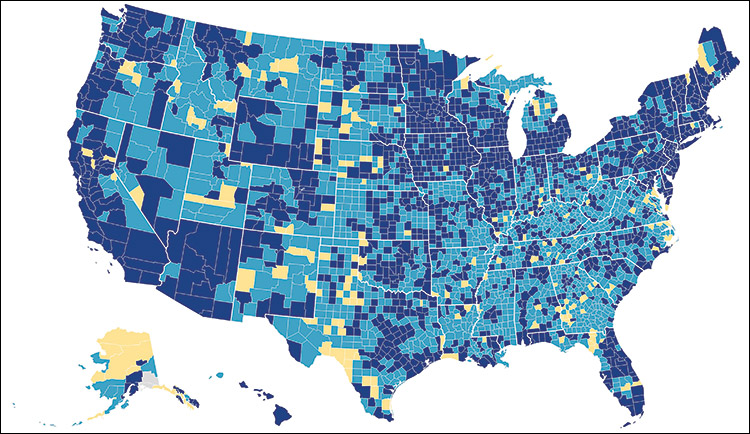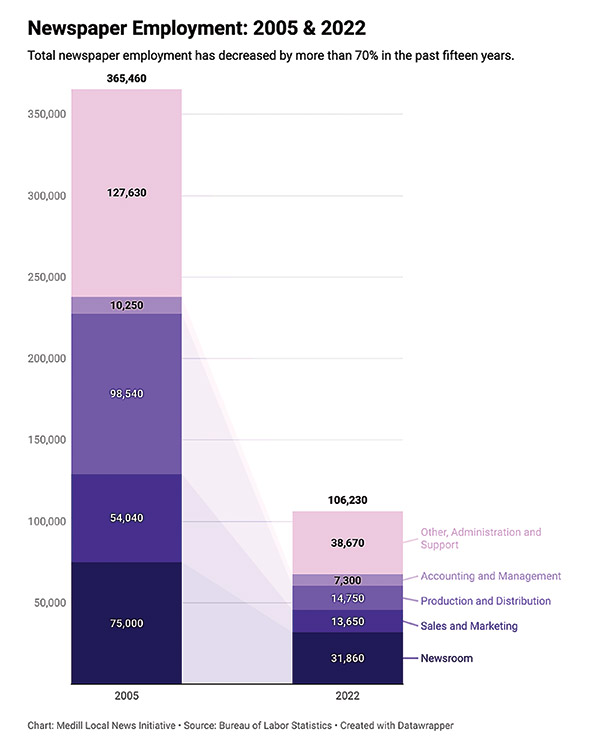Shattered papers and ‘ghosts’ without local news

Editor’s note: Northwestern University continues to be a leader on tracking the state of local news in the United States. In 2023, they were able to report about more specific trends related to the impact of ‘ghost newspapers’ with no staff reporters. Sounds absurd but unfortunately, it does exist. The good news is that promising business models are emerging which are very similar to the one used by the Claremont Courier. Here is one story from a city of 40,000 residents with a longtime community newspaper that continues to publish — without any editorial staff. —PW
by Al Cross | Northwester Local news Initiative
The Hutchinson News in central Kansas greeted its subscribers September 5 with a front-page feature about the Hutchinson Senior Center that included a big photo of seniors kayaking — on a lake with a thickly forested shore.
That’s not the landscape of Hutchinson, some 50 miles northwest of Wichita. And that’s not the name of its senior center.
The “local” centerpiece instead told baffled readers all about activities offered by the senior center in Hutchinson, Minn., more than 500 miles away as the crow flies. The Hutchinson News, serving a city of 40,000, no longer had a single reporter or editor on staff, so the story was written by a confused freelancer who, though based in Kansas, failed to notice that her online search had yielded the phone number of a faraway senior citizen center. She got the assignment from a Gannett editor based 185 miles to the southwest, in Bartlesville, Okla.
What Gannett’s corporate relations staff called an “oversight,” while declining to be interviewed, provides a vivid picture of what has happened to hundreds of newspapers that once covered small cities, towns and rural areas across America. They’ve become “ghost papers” with either no local journalists remaining on staff or so few that the paper’s ability to provide critical news and information to residents in that community has been severely curtailed.
In the U.S. there are more than 3,100 counties in 50 states. Almost three-fourths of those counties — 2,259 — are located more than 50 miles from the closest city. Over the past two decades, the 46 million residents who live in these more rural counties have experienced a dual loss.
First came the loss of hundreds of weekly newspapers, which were often the prime, if not sole, source of critical news and information about important events and issues. Amid that came the loss of hundreds of local reporters and editors, as the newsrooms of the surviving weeklies and small dailies were hollowed out.
The loss of local print advertising to digital platforms such as Google and Facebook came later to news outlets in towns and rural areas than it did to large metropolitan newspapers. But it arrived with force after 2012 and accelerated during the pandemic. This shift has led to many sudden newspaper closures and mergers, as well as news outlets’ sales to distant chains that cut local staff, customer service and quality of coverage. In many of these counties, ghost newspapers publish print or electronic editions but employ no professional journalists and instead rely on freelancers, syndicated material and stories from other chain properties.
Since 2005, 875 of the 2,900 newspapers that have been permanently shuttered were in these smaller counties. Today 195 of those mostly rural counties have no local newspaper or any other source of local news. An additional 1,387 counties have only one local news source — invariably a weekly or small daily. Based on the higher-than-average poverty rates and the population size of those counties, the State of Local News project determined that 228 are at elevated risk of losing their sole remaining news source.
There is no similar detailed accounting of the number of ghost newspapers, largely because owners are reluctant to share staffing numbers. However, a recent review by the Local News Initiative of the 70 smallest newspapers owned by two of the largest newspaper chains, Lee and Gannett, found that three dozen had no listing for any local journalists on staff.
Since 2005, the number of journalists employed by newspapers has declined by 60%, a loss of 43,000 reporters and editors. In recent years large chains have severed the most journalists, leading to dozens of ghost newspapers.
Alarmed by the lack of local news in the Gannett-owned Hutchinson News, Michael Glenn, a 16- year-old high school debater, started the Hutchinson Tribune on Substack on July 4. Glenn says the Tribune is currently publishing about five times as many local news articles as the Hutchinson News, and that he and his partner, a local librarian, are starting to sell advertising to their growing audience.
Unfortunately, very few rural communities have an energetic entrepreneur like Glenn willing to devote the time and effort to start an alternative replacement for either a shuttered newspaper or a ghost publication.
However, research shows that people still need and want local news, and in some small cities, towns and rural communities, new sustainable business models are beginning to emerge.
This is part of an occasional series reporting on the status of local news in America, edited by Peter Weinberger.










0 Comments